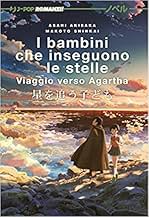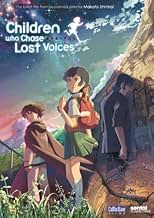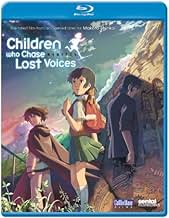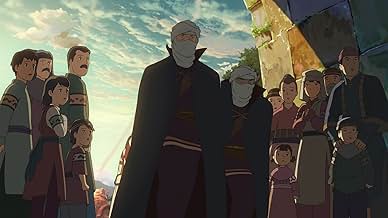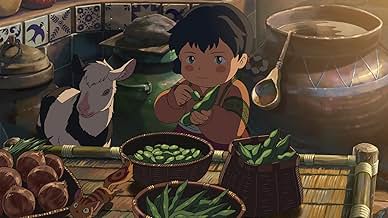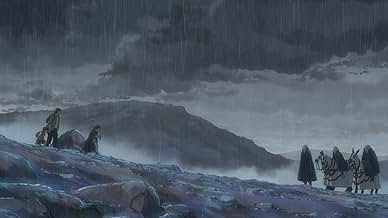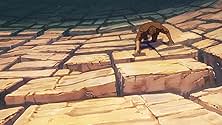AVALIAÇÃO DA IMDb
7,1/10
18 mil
SUA AVALIAÇÃO
Uma história envolvendo amor jovem e música misteriosa, vinda de um rádio de cristal deixado como lembrança por um pai ausente, que leva uma jovem heroína ao fundo de um mundo escondido.Uma história envolvendo amor jovem e música misteriosa, vinda de um rádio de cristal deixado como lembrança por um pai ausente, que leva uma jovem heroína ao fundo de um mundo escondido.Uma história envolvendo amor jovem e música misteriosa, vinda de um rádio de cristal deixado como lembrança por um pai ausente, que leva uma jovem heroína ao fundo de um mundo escondido.
- Prêmios
- 1 vitória e 7 indicações no total
Hisako Kanemoto
- Asuna Watase
- (narração)
Miyu Irino
- Shin
- (narração)
- …
Kazuhiko Inoue
- Ryûji Morisaki
- (narração)
Junko Takeuchi
- Mimi
- (narração)
Fumiko Orikasa
- Asuna no haha
- (narração)
Sumi Shimamoto
- Risa Morisaki
- (narração)
Tamio Ôki
- Amorôto no rôjin
- (narração)
Aki Kanada
- Seito
- (narração)
- (as Aki Kaneda)
Ai Horanai
- Seito
- (narração)
Saya Horigome
- Seito
- (narração)
Mayumi Tsuchiya
- Seito
- (narração)
Mao Kobayashi
- Seito
- (narração)
- (as Satomi Saitô)
Naomi Matamura
- Murabito
- (narração)
Mariko Nagahama
- Murabito
- (narração)
Mika Ishibashi
- Murabito
- (narração)
Hiroko Midorikawa
- Murabito
- (narração)
Yûtarô Honjô
- Murabito
- (narração)
Hiroshi Shimozaki
- Murabito
- (narração)
Avaliações em destaque
So I guess I wasn't the only one really excited about Shinkai's new release, "Hoshi o ou Kodomo". With his previous work like "Kumo no mukô, Yakusoku no Basho", "Byôsoku 5 Senchimêtoru" and "Hoshi No Koe" Makato Shinkai has never ceased to impress us with the visual detail and animated scenery, a wonderful blend of color and light that breathes life into the dreamlike landscapes. If you're familiar with his previous films you know what to expect visually, but now to the actual content.
Unfortunately, "Hoshi o ou Kodomo" doesn't share the same uniqueness as say "Kumo no mukô, yakusoku no basho" and "Hoshi No Koe". I could notice resemblance and inspiration from a couple of films, especially Miyazaki's "Spirited Away" and "Princess Mononoke". I even thought of Andrei Tarkovsky's "Stalker" at some points, with the resemblance of the two main characters setting out on a journey through unknown, otherwordly plains, being lonely and in mourning, seeking to make their strongest wishes come true. This is of course the case in most films and in the creation of any aesthetic work, the artist creates something new under the influence of others whether they want it or not. Especially when it comes to film, which affect us on many levels, changing our thought patterns and point of view. The story was compelling and had me engaged from beginning to end. I'm weak when it comes to these spiritual and existential messages and symbolism often presented in Japanese cinema, especially in animations.
"Hoshi o ou Kodomo" is certainly no exception with a centered theme of life and death and the mysterious rumours of a world within the Earth, a place where ancient knowledge and memories dwell, and ancient divine entities wander the land, who used to give guidance to humankind. This film can be interpreted in many different ways, this was mine. The soundtrack is both ethereal and powerful, intertwining with the visuals in a flawless way.
To summarize, Shinkai's new work is a touching and compelling tale of friendship, love and hatred, truth, deceit, but foremost about letting go.
"Hoshi o ou Kodomo" is without any doubt a worthy addition to Makato Shinkai's previous works.
My rating: 8/10
Unfortunately, "Hoshi o ou Kodomo" doesn't share the same uniqueness as say "Kumo no mukô, yakusoku no basho" and "Hoshi No Koe". I could notice resemblance and inspiration from a couple of films, especially Miyazaki's "Spirited Away" and "Princess Mononoke". I even thought of Andrei Tarkovsky's "Stalker" at some points, with the resemblance of the two main characters setting out on a journey through unknown, otherwordly plains, being lonely and in mourning, seeking to make their strongest wishes come true. This is of course the case in most films and in the creation of any aesthetic work, the artist creates something new under the influence of others whether they want it or not. Especially when it comes to film, which affect us on many levels, changing our thought patterns and point of view. The story was compelling and had me engaged from beginning to end. I'm weak when it comes to these spiritual and existential messages and symbolism often presented in Japanese cinema, especially in animations.
"Hoshi o ou Kodomo" is certainly no exception with a centered theme of life and death and the mysterious rumours of a world within the Earth, a place where ancient knowledge and memories dwell, and ancient divine entities wander the land, who used to give guidance to humankind. This film can be interpreted in many different ways, this was mine. The soundtrack is both ethereal and powerful, intertwining with the visuals in a flawless way.
To summarize, Shinkai's new work is a touching and compelling tale of friendship, love and hatred, truth, deceit, but foremost about letting go.
"Hoshi o ou Kodomo" is without any doubt a worthy addition to Makato Shinkai's previous works.
My rating: 8/10
"Your Name" ended up being one of my favorite movies of last year, and one of my favorite anime of all time, so I went into this film with relatively high expectations, and as a result, I was slightly disappointed. Don't get me wrong; this movie has a lot of things going for it. I loved the melancholic, almost lazy piano music that plays for the majority of the film- it creates a magical atmosphere that works wonders with the animation style and overall arc of the story. The way that characters and creatures are designed is memorable, and sometimes it's even a little bit frightening and bizarre, but that totally worked for me. The landscapes are beautiful and sometimes strange (though we never quite reach the level of artistic mastery that came with "Your Name"). There were some parts where I really felt for the characters, and then there were other times when I was quite bored.
According to Japanese anime director Makoto Shinkai, his latest film Children who Chase Lost Voices from Deep Below is a study of "how people are connected" and the relationship between individuals. Although the film is designed primarily for a young audience, adult themes of love and loss abound in its story of mourning lovers attempting to reach out to them across the dimensions. Its theme can also be said to encompass the Four Noble Truths of Buddhism: Life is full of suffering, suffering is caused by attachment, release from suffering is attainable, and there is a path to the end of suffering. Here, the path is setting your loved one free and "saying hello" to a world without them.
Nominated for best animated feature at the Asian Pacific Screen Awards in 2011, the film takes us on a journey to a land deep below the surface of the Earth, the legendary country called Agartha where it is rumored the dead can be brought back to life. Unlike other visionary depictions of mythical kingdoms, Agartha has no magical cities of gold with tall towers and futuristic technology, but rather a rural environment of towns and villages in which mundane life appears similar to those who are called the "topsiders", those who live on the surface (us).
Supported by the ethereal soundtrack of Tenmon http://www.youtube.com/watch?v=NpRFbY189bo, the plot centers around the quest of a young girl of around 11 or 12 named Asuna Watase (Hisako Kanamoto) to find the mythical Agartha, talked about by her substitute teacher, Ryugi Morisaki (Kazuhiko Inoue). Mirroring the Greek legend of Orpheus and Eurydice and its Japanese equivalent, the myth of Izanagi and Izanami, Morisaki longs to travel to Agartha to find his deceased wife Lisa and bring her back with him to Earth. Asuna has also lost a loved one. Her father died when she was little, compelling her mother to work long hours as a nurse. Lonely and withdrawn, she spends her time after school in her private mountain retreat listening to the crystal radio her father had given her.
One day, after hearing beautiful and strange music from her radio, she meets a young boy with supernatural powers named Shun (Miyu Irino), who saves her from the attack of a ferocious bear-like creature. Returning the next day, Shun tells her that he is from Agartha, a land deep inside the core of the hollow Earth. Surprised by a blessing from Shun in the form of a kiss on the forehead, Asuna leaves suddenly but when she comes back the following day, she learns sadly that Shun, while trying to reach for the stars, has fallen off a ledge and died.
Telling her story to Mr. Morisaki, the teacher informs her that in the ancient times, humans were guided by creatures known as "Quetzalcoatls," a name we know from Mesoamerican history as the Aztec God called the "Feathered Serpent" who, according to legend, promised to return one day to lead his people. When Asuna once again returns to her hiding place, she discovers a boy who looks like Shun but who claims to be his brother Shin (Irino). Morisaki poses as a warrior of the group called the Arch Angels, those who want to reach Agartha but are interested only in its wealth and superior knowledge. Morisaki, however, simply wants to find his dead wife Lisa.
Using a device known as a "clavis," he and Asuna enter the underground realms and begin their travel to the Gate of Life and Death, "the undiscovered country from whose bourn no traveler returns." The journey through the subterranean realms is filled with both beauty and the obligatory horror, the norm for sci-fi adventure stories for children. Asuna and Morisaki are attacked by fearful long-toothed monsters (children must have their nightmares), and have to rely on the powers of Shin to save them, even though he had been given the task of retrieving the "clavis" which they possess.
The remainder of the film is filled with numerous plot twists and turns that introduce other characters and some of it can be confusing. The viewer is treated, however, to ravishing visuals that invoke the experience of dimensions far beyond our limited reality. Ultimately, Morisaki and Asuna are forced to choose whether or not they wish to pursue their goal in Agartha or let go and surrender to the wisdom of the universe, and the theme song of the film by Anri Kumaki, "Hello, Goodbye and Hello," http://www.youtube.com/watch?v=UgWb2YSTovA exquisitely embraces the conflicting emotions the characters feel.
Whether or not you have recently lost a loved one, you may find the tears hard to resist. Lost Voices is the first of Shinkai's films that I have seen and it definitely encourages me to see more. Comparisons of Shinkai's themes and style have been made with those of Hayao Miyazaki, but since I have only seen one of Miyazaki's films, I will leave the comparisons to others and just enjoy the warm glow of Shinkai's stunning achievement.
Nominated for best animated feature at the Asian Pacific Screen Awards in 2011, the film takes us on a journey to a land deep below the surface of the Earth, the legendary country called Agartha where it is rumored the dead can be brought back to life. Unlike other visionary depictions of mythical kingdoms, Agartha has no magical cities of gold with tall towers and futuristic technology, but rather a rural environment of towns and villages in which mundane life appears similar to those who are called the "topsiders", those who live on the surface (us).
Supported by the ethereal soundtrack of Tenmon http://www.youtube.com/watch?v=NpRFbY189bo, the plot centers around the quest of a young girl of around 11 or 12 named Asuna Watase (Hisako Kanamoto) to find the mythical Agartha, talked about by her substitute teacher, Ryugi Morisaki (Kazuhiko Inoue). Mirroring the Greek legend of Orpheus and Eurydice and its Japanese equivalent, the myth of Izanagi and Izanami, Morisaki longs to travel to Agartha to find his deceased wife Lisa and bring her back with him to Earth. Asuna has also lost a loved one. Her father died when she was little, compelling her mother to work long hours as a nurse. Lonely and withdrawn, she spends her time after school in her private mountain retreat listening to the crystal radio her father had given her.
One day, after hearing beautiful and strange music from her radio, she meets a young boy with supernatural powers named Shun (Miyu Irino), who saves her from the attack of a ferocious bear-like creature. Returning the next day, Shun tells her that he is from Agartha, a land deep inside the core of the hollow Earth. Surprised by a blessing from Shun in the form of a kiss on the forehead, Asuna leaves suddenly but when she comes back the following day, she learns sadly that Shun, while trying to reach for the stars, has fallen off a ledge and died.
Telling her story to Mr. Morisaki, the teacher informs her that in the ancient times, humans were guided by creatures known as "Quetzalcoatls," a name we know from Mesoamerican history as the Aztec God called the "Feathered Serpent" who, according to legend, promised to return one day to lead his people. When Asuna once again returns to her hiding place, she discovers a boy who looks like Shun but who claims to be his brother Shin (Irino). Morisaki poses as a warrior of the group called the Arch Angels, those who want to reach Agartha but are interested only in its wealth and superior knowledge. Morisaki, however, simply wants to find his dead wife Lisa.
Using a device known as a "clavis," he and Asuna enter the underground realms and begin their travel to the Gate of Life and Death, "the undiscovered country from whose bourn no traveler returns." The journey through the subterranean realms is filled with both beauty and the obligatory horror, the norm for sci-fi adventure stories for children. Asuna and Morisaki are attacked by fearful long-toothed monsters (children must have their nightmares), and have to rely on the powers of Shin to save them, even though he had been given the task of retrieving the "clavis" which they possess.
The remainder of the film is filled with numerous plot twists and turns that introduce other characters and some of it can be confusing. The viewer is treated, however, to ravishing visuals that invoke the experience of dimensions far beyond our limited reality. Ultimately, Morisaki and Asuna are forced to choose whether or not they wish to pursue their goal in Agartha or let go and surrender to the wisdom of the universe, and the theme song of the film by Anri Kumaki, "Hello, Goodbye and Hello," http://www.youtube.com/watch?v=UgWb2YSTovA exquisitely embraces the conflicting emotions the characters feel.
Whether or not you have recently lost a loved one, you may find the tears hard to resist. Lost Voices is the first of Shinkai's films that I have seen and it definitely encourages me to see more. Comparisons of Shinkai's themes and style have been made with those of Hayao Miyazaki, but since I have only seen one of Miyazaki's films, I will leave the comparisons to others and just enjoy the warm glow of Shinkai's stunning achievement.
Every culture has a story about the Underworld, where the souls of the dead reside and where, sometimes, the living can find their way in hopes of bringing a loved one back to life. In "Children Who Chase Lost Voices from Deep Below," Agartha is the name of that Underworld, and when young Asuna (voiced by Hisako Kanemoto) finds herself interacting with a boy from Agartha, Shun (voiced by Miyu Irino), her whole world is changed. Shun saves her from a frightening creature, but then he himself is killed. In the meantime, the substitute teacher taking over for the regular teacher of Asuna's class, Mr. Morisaki (voiced by Kazuhiko Inoue), is all-too-familiar with stories from and about Agartha, and he is determined to get there in order to bring his wife, dead 10 years, back to the world of the living. But the balance of all the worlds depends on such things not happening, and there are many forces arrayed against Mr. Morisaki and young Asuna who has willingly joined him in his quest, for she hopes to find a living Shun. Instead she finds Shun's younger brother, Shin (also voiced by Miyu Irino), whose loyalties and desires are not perhaps favourable to Asuna....
Anime is Japan's version of "cartoons," although they tend to be much more complex and beautiful than Hanna-Barbera ever thought of, and this is one very beautiful piece of work. The images are exquisite and the colours are wonderful, the underworld of Agartha is just as real as the everyday world Asuna initially inhabits. And the storyline, essentially a meditation on letting go of the past while still being free to mourn lost loved ones, is much more resonant for adults than for kids. The writer and director, Makoto Shinkai, has been compared with the great anime master, Hayao Miyazaki, and while those are mighty shoes indeed to fill, Shinkai's work has the same kind of gentleness and beauty; he is surely a talent to watch for in the coming years. A beautiful film, and well worth seeking out.
Anime is Japan's version of "cartoons," although they tend to be much more complex and beautiful than Hanna-Barbera ever thought of, and this is one very beautiful piece of work. The images are exquisite and the colours are wonderful, the underworld of Agartha is just as real as the everyday world Asuna initially inhabits. And the storyline, essentially a meditation on letting go of the past while still being free to mourn lost loved ones, is much more resonant for adults than for kids. The writer and director, Makoto Shinkai, has been compared with the great anime master, Hayao Miyazaki, and while those are mighty shoes indeed to fill, Shinkai's work has the same kind of gentleness and beauty; he is surely a talent to watch for in the coming years. A beautiful film, and well worth seeking out.
A coming of age story dealing with Asuka, she is the protagonist of this story, who spends her days alone listening to the mysterious music emitted by an old crystal radio, a gift that her absent father gave her as a memento before he died. Attacked by a monstrous creature, rescued by a mysterious boy named Shun and hunted by a relentless enemy,. Asuna will be immersed in an ancient mystery that could be the secret of life itself. It leads the young heroine deep into a hidden world, to a legendary country with several surprises. A journey to say goodbye !. A girl who does not yet realise her loss, and a boy from a foreign land searching for his place !. A man who refuses to accept his loss !. Each with their own feelings in their hearts, they set out on a journey into the depths of the world !.
The beauty of the settings, the characters, maarvellous drawings and the fantasy elements leave no doubt as to why the director has been labeled as the new Hayao Miyazaki. This wonderful film is plenty of fantasy , adventures, drama, spectacular combats and with ecological message . The picture is narrated with sensibility and sense of wonder and quite entertaining. The film has all the necessary elements to be a success among anime fans. It is a story of great fantasy involving young love and a mysterious music with a courageous protagonist who enters a beautiful world full of colorful settings and strange creatures, clearly influenced by Hayao Miyazaki's classic 'Princess Mononoke'. There's also a deep critical about nature exploiting and disasters and rampage caused by the encroaching human civilization. With an impressive quality of colors and animation, this is one of the best anime of 2011. A fantastic journey to a parallel world, Shinkai directs this fable that connects the most earthly part of nature with the most mystical part.
It is inevitable to compare the style of the film with that of Hayao Miyazaki and his Ghibli studio, of which Shinkai confesses to having always admired it. In addition, the music composed by Tenmen, a friend and regular collaborator of the director, stands out. The motion picture was professional and stunningly directed by Makoto Shinkai After spending a year in London, Makoto returned to Japan with renewed energy to undertake a new film project that would follow in the footsteps of his previous ones. Focusing on the loss of loved relatives, he also explored the ways in which we can overcome this loss. Unlike in other works, in which Shinkai himself created a novel version, here he opted for two different adaptations in the form of Manga: ¨Journey to Agartha: Children who chase lost voiced from deep below¨ by Tomoko Mitani and ¨Journey to Agartha: Children who come from deep below¨ by Asahi Hidaka. The film was nominated for the award for best animated design at the Asia Pacific 2011, as well as the Golden Raven at the Brussels Fantasy Festival that same year. Hoshi o Ou Kodomo(2011) rating: 7.5/10. Better than average.
The beauty of the settings, the characters, maarvellous drawings and the fantasy elements leave no doubt as to why the director has been labeled as the new Hayao Miyazaki. This wonderful film is plenty of fantasy , adventures, drama, spectacular combats and with ecological message . The picture is narrated with sensibility and sense of wonder and quite entertaining. The film has all the necessary elements to be a success among anime fans. It is a story of great fantasy involving young love and a mysterious music with a courageous protagonist who enters a beautiful world full of colorful settings and strange creatures, clearly influenced by Hayao Miyazaki's classic 'Princess Mononoke'. There's also a deep critical about nature exploiting and disasters and rampage caused by the encroaching human civilization. With an impressive quality of colors and animation, this is one of the best anime of 2011. A fantastic journey to a parallel world, Shinkai directs this fable that connects the most earthly part of nature with the most mystical part.
It is inevitable to compare the style of the film with that of Hayao Miyazaki and his Ghibli studio, of which Shinkai confesses to having always admired it. In addition, the music composed by Tenmen, a friend and regular collaborator of the director, stands out. The motion picture was professional and stunningly directed by Makoto Shinkai After spending a year in London, Makoto returned to Japan with renewed energy to undertake a new film project that would follow in the footsteps of his previous ones. Focusing on the loss of loved relatives, he also explored the ways in which we can overcome this loss. Unlike in other works, in which Shinkai himself created a novel version, here he opted for two different adaptations in the form of Manga: ¨Journey to Agartha: Children who chase lost voiced from deep below¨ by Tomoko Mitani and ¨Journey to Agartha: Children who come from deep below¨ by Asahi Hidaka. The film was nominated for the award for best animated design at the Asia Pacific 2011, as well as the Golden Raven at the Brussels Fantasy Festival that same year. Hoshi o Ou Kodomo(2011) rating: 7.5/10. Better than average.
Você sabia?
- CuriosidadesBefore the film's release in May 2011, manga adaptations were set to begin serialization in April 2011
- Trilhas sonorasHello Goodbye & Hello
Lyrics & Music by Anri Kumaki
Arranged by Shun'ya Shimizu
Performed by Anri Kumaki
Principais escolhas
Faça login para avaliar e ver a lista de recomendações personalizadas
- How long is Children Who Chase Lost Voices?Fornecido pela Alexa
Detalhes
- Data de lançamento
- País de origem
- Central de atendimento oficial
- Idiomas
- Também conhecido como
- Children Who Chase Lost Voices
- Empresas de produção
- Consulte mais créditos da empresa na IMDbPro
Bilheteria
- Faturamento bruto mundial
- US$ 645.560
- Tempo de duração
- 1 h 56 min(116 min)
- Cor
- Mixagem de som
- Proporção
- 1.85 : 1
Contribua para esta página
Sugerir uma alteração ou adicionar conteúdo ausente


